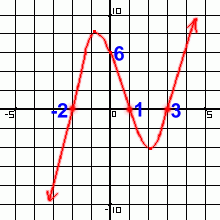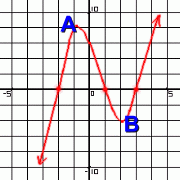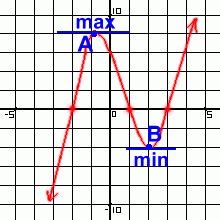|
We'll choose a simple cubic function: y = x3 - 2x2 - 5x + 6 You have learned how to graph this function using the y-intercept (0 , 6) and by finding its zeros, using the Factor Theorem; when you factor the polynomial, you get: We now have a y-intercept of (0 , 6) and zeros (1 , 0), (3 , 0) and (-2 , 0) This is the graph that results: 
In order to do this, we are going to differentiate the polynomial function y = x3 - 2x2 - 5x + 6. We want to find the first derivative of this function. Since it's a polynomial, we can do this by finding the first derivative of each term. The procedure is simple: for each term, bring the exponent out front and multiply by any coefficient already there. The remaining exponent will be one less than it was before. Let's differentiate the polynomial, term by term: x3 becomes 3x2 -2x2 becomes -4x1 -5x1 becomes -5x0 or just -5 6 (or 6x0) becomes 0x-1 (or just 0) So the function y = x3 - 2x2 - 5x + 6 has the derivative function y' = 3x2 - 4x - 5 The notation we're using for a first derivative function is y'. There are three common notations:  The derivative function can be thought of as the slope function for the original graph. By using the function y' = 3x2 - 4x - 5, you can determine the slope at any point x just by filling in x.
Now back to our original problem, how to find the local maximum and minimum points of the graph.
Using the General Quadratic Formula, (since the equation won't factor), we get the following two rounded solutions : x = -0.8 and x = 2.1 Next, filling each of these values into the original function y = x3 - 2x2 - 5x + 6 yields the corresponding rounded y values of 8.2 and -4.1 So we now have the values where the slope is zero: A (-0.8 , 8.2) and B (2.1 , -4.1) Here's a summary of the method we used to find the local maximum and minimum points: Differentiate the function. Set that first derivative equation to be equal to zero (because the slope is zero at the max and min points). Solve for the two 'x' values. Substitute them into the original equation to find the corresponding 'y' values. |

